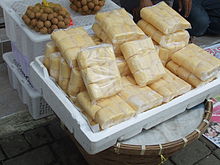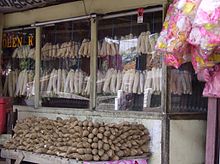- Tapai
-
Tapai (ta-pie) or tape (ta-peh), sometimes referred to as peuyeum (from Sundanese language) , is a traditional fermented food found throughout much of East- and Southeast Asia. It is a sweet or sour alcoholic paste[1] and can be used directly as a food or in traditional recipes. Tapai can be made from a variety of carbohydrate sources, but typically from cassava, white rice, or glutinous rice.[1][2] Fermentation is performed by a variety of moulds including Aspergillus oryzae, Rhizopus oryzae, Amylomyces rouxii or Mucor spp, and yeasts including Saccharomyces cerevisiae, and Saccharomycopsis fibuliger, Endomycopsis burtonii and others, along with bacteria.[1][2] Tapai is also used to make alcoholic beverages.
Contents
Ragi Tapai
Tapai is made by inoculating a carbohydrate source with the required microorganisms in a starter culture. This culture has different names in different regions, shown in the table below. The culture can be naturally captured from the wild, by mixing rice flour with ground spices (include garlic, pepper, chili, cinnamon), cane sugar or coconut water, slices of ginger or ginger extract, and water to make a dough.[2] The dough is pressed into round cakes, about 3cm across and 1 cm thick, and left to incubate on trays with banana leaves under and over them for two to three days. They are then dried and stored, ready for their next use.
Region China Indonesia/Malaysia Korea Philippines Thailand Name peh-chu ragi tapai nuruk bubod, tapay look-paeng Preparation
Ragi tapai is used to ferment different types of carbohydrates such as cassava, cooked white rice or glutinous rice, and sometimes sweet potatoes. The general process is to wash and cook the target food, cool to about 30°C, mix in some powdered ragi tapai, and rest in covered jars for one to two days. With cassava and sweet potato, the tubers are washed and peeled before cooking, then layered in baskets with ragi tapai sprinkled over each layer.
The finished tapai will taste sweet with a little alcohol, and can be consumed, or left for several days more to become sour.
Region Cambodia China India Indonesia Korea Malaysia Philippines Singapore Thailand white rice chao lao-chao, chiu-niang tapai nasi nuruk? tapai nasi binuburang basi, tapay basi tapai nasi khao-mak glutinous rice Bhattejaanr tapai ketan tapai pulut cassava tapai ketala, tape singkong, tape telo, peuyeum tapai ubi kayu binuburang ube, tapay panggi Name of a place
It is also being used as a name of a place, Wakaf Tapai in Terengganu Malaysia. [3] The town is so named from the Malay words wakaf, meaning small hut for travelers resting[4], and the word tapai.
References
- ^ a b c Haard, Norman F.; et al. (1999). "Fermented Cereals. A Global Perspective". United Nations FAO. http://www.fao.org/docrep/x2184e/x2184e09.htm. Retrieved 2006-07-28.
- ^ a b c Gandjar, Indrawati (August 2003). "TAPAI from Cassava and Cereals" (pdf). University of Indonesia. http://plantpro.doae.go.th/worldfermentedfood/I_10_Gandjar.pdf. Retrieved 2006-07-28.
- ^ Chinese minority in a Malay state: the case of Terengganu in Malaysia, Chee Beng Tan
- ^ The Malayan law journal, Volume 3, Bashir Ahmad Mallal
External links
Categories:- Fermented foods
- Indonesian snack foods
- Philippine cuisine
Wikimedia Foundation. 2010.


